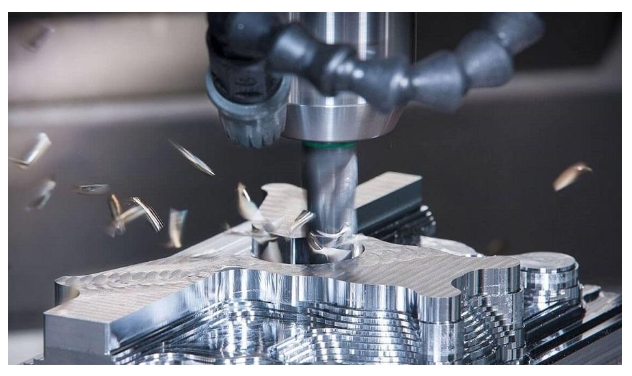6 Things You Should Know About CNC Machining Aluminum?
Aluminum’s unique combination of properties makes it a common material in CNC machining across various industries. The versatility of the metal spans from aerospace components to architectural tools and provides many advantages in each use case.
However, getting optimal results when using aluminium for CNC machining requires understanding its characteristics and the CNC machining process. That’s why we are here to address 6 things you should know about CNC machining aluminium to get the best results.
So, if you want to rush your next aluminium project with CNC machining, make sure to check out the article before.
Does CNC Machining Work for Aluminum?
CNC machining is a highly effective and versatile process for working with aluminium. CNC-machined aluminium is an excellent choice if your project demands high-precision, lightweight parts with good strength. In fact, aluminium is one of the most popular materials for CNC machining due to several key reasons. These include –
Easy Machinability
Aluminium material has a soft and ductile nature that allows CNC machines to effortlessly cut through it. It also helps in taking the material through various types of machining processes. You can work on aluminium for different CNC machining techniques, which we will discuss in a bit.
Versatility
With a vast selection of aluminium alloys at your disposal, you can choose the perfect material for your specific needs. You get high strength, excellent corrosion resistance, and balance in various aluminium alloys out there. In short, you get an option for everything.
Strength-to-weight ratio
Aluminum offers an incredible strength-to-weight ratio. This translates to complex and intricate parts that are surprisingly lightweight and ideal for applications in aerospace and transportation. CNC machining unlocks this potential by precisely crafting strong yet feathery components.
How Many Types of CNC Machining Techniques Can Be Used on Aluminum?
As we discussed above, aluminium is a great material for machinability. This means you can use various CNC machining techniques on aluminium to create different parts and designs.
Here, we discuss some CNC machining techniques, their benefits, their ideal use, and how the process is done. This should clarify which technique you should choose.
1- CNC Milling
CNC milling is a subtractive manufacturing process that utilises a multi-axis computer numerically controlled machine. A rotary cutting tool with multiple edges rapidly spins along its axis. The CNC program precisely coordinates the movement of the tool and the aluminium workpiece, effectively carving away material to create the desired shape.
Benefits for Aluminum
CNC milling’s strength lies in its versatility. It can handle complex 2D and 3D geometries with high precision. Aluminum’s soft nature allows faster machining speeds and cleaner cuts than harder metals.
Ideal for Aluminum When
Your project requires intricate features, pockets, slots, or 3D profiles. Due to its flexibility, CNC milling is perfect for one-off prototypes or small-batch production runs.
How Milling Works
- The aluminium workpiece is securely fastened to the CNC milling table.
- The CNC program dictates the toolpath, precisely controlling the movement of the cutting tool along multiple axes (X, Y, and Z, with additional rotary axes on some machines for complex 3D geometries).
- With each pass, the rotating end mill removes material from the aluminium workpiece, gradually creating the programmed design.
- Coolant is often used to prevent overheating and chip buildup, ensuring clean cuts and optimal tool life.
2- CNC Turning
CNC turning is another subtractive process ideal for creating cylindrical or rotationally symmetrical parts. The aluminium workpiece is secured in a rotating chuck on a lathe, while a single-point cutting tool removes material along the axis of rotation.
Benefits for Aluminum
The process produces high-precision, cylindrical parts with superior surface finishes. Aluminum’s machinability allows for faster production times compared to turning harder metals.
Ideal for Aluminum When
Your project requires parts like shafts, bushings, gears, or other components with rotational symmetry.
How Turning Works
- The aluminium rod or bar stock is securely held in the lathe’s chuck.
- The CNC program controls the rotation of the workpiece and the movement of the cutting tool along the X and Z axes.
- The single-point cutting tool progressively removes material from the rotating aluminium stock, shaping it into the desired cylindrical form.
- Coolant minimises friction and heat generation, ensuring precise dimensions and a smooth finish.
3. CNC Drilling and Tapping
These complementary techniques are often used in conjunction with milling or turning. CNC drilling uses a specialised drill bit to create precise holes of various sizes and depths in the aluminium workpiece.
CNC tapping follows drilling, using a threaded tool to create internal threads within the holes to allow for screw fastening.
Benefits for Aluminum
CNC drilling and tapping offer high precision and repeatability for creating accurate holes in aluminium parts. Aluminum’s machinability allows for faster drilling speeds and cleaner hole walls compared to some harder metals.
Ideal for Aluminum When
Your project requires precise holes for fasteners, pins, or other functional elements. These techniques are essential for integrating various components within your aluminium design.
How Drilling Works
- The CNC program dictates each hole’s location, size, and depth.
- The CNC machine positions the drill bit precisely over the aluminium workpiece’s designated location.
- The drill bit rotates and plunges into the aluminium, creating a clean and precise hole.
- Coolant often minimises friction and chip buildup, ensuring accurate hole dimensions.
How Tapping Works
- Following drilling, a CNC tapping tool with the matching thread pattern is loaded into the machine.
- The CNC program controls the tool’s movement to create internal threads within the pre-drilled hole.
- The tapping tool progressively cuts away material, forming the desired threads for secure screw attachment.
4. CNC Waterjet Cutting
This non-traditional technique utilises a high-pressure jet of water mixed with abrasive particles to cut through aluminium. The pressurised water stream acts like a miniature cutting tool, precisely eroding the material along the programmed path.
Benefits for Aluminum
CNC waterjet cutting excels at creating intricate shapes or thin sheet metal parts without heat distortion, which can occur with traditional machining methods. It’s also suitable for cutting a variety of materials besides aluminium.
Ideal for Aluminum When:
Your project requires complex cutouts, thin sheet metal components, or a process that minimises heat impact on the aluminium.
How Waterjet Cutting Works
- A high-pressure pump generates a powerful jet of water mixed with abrasive garnet particles.
- The CNC program controls the movement of the waterjet nozzle across the aluminium sheet.
- The pressurised waterjet stream erodes the aluminium along the programmed path, creating a clean and precise cut.
- A capture tank collects the water and abrasive mixture for proper disposal.
5. CNC Laser Cutting
Another non-traditional technique, CNC laser cutting, utilises a focused laser beam to melt and vaporise the aluminium, creating a clean cut with minimal material waste. The high-powered laser beam is a precise cutting tool guided by the CNC program.
Benefits for Aluminum
CNC laser cutting offers exceptional precision and clean cuts for thin aluminium sheets. It’s also a fast and efficient process for creating intricate designs.
Ideal for Aluminum When
Your project requires thin aluminium sheet metal parts with intricate details or very small features. Laser cutting is ideal for high-volume production runs due to its speed and repeatability.
How it Works
- A high-powered laser beam is generated and focused through a nozzle.
- The CNC program precisely controls the movement of the laser beam across the aluminium sheet.
- The concentrated laser energy melts and vaporises the aluminium along the programmed path, resulting in a clean and narrow cut.
- A fume extraction removes any vaporised material or dust particles generated during cutting.
What is the best aluminium for CNC machining?
There isn’t a single “best” aluminium for CNC machining because the ideal choice depends on your project’s specific requirements. Here’s a breakdown of some popular aluminium alloys and their strengths to help you pick the perfect one:
Common Aluminum Alloys for CNC Machining:
- 6061-T6
This is the most widely used aluminium alloy for CNC machining due to its excellent machinability, strength, and corrosion resistance balance. It’s a good all-around choice for general-purpose parts that don’t require extreme properties.
- 5052
When you require formability, the 5052 alloy is a perfect choice. It is ideal for parts that require bending or shaping after machining. It also has good corrosion resistance, making it suitable for outdoor applications. However, its machinability is lower compared to 6061-T6.
- 7075-T6
With the 7075-T6, you can get the highest strength among commonly used CNC machining aluminium alloys. It’s ideal for high-stress applications like aerospace components or machine parts. However, a drawback is that it’s more susceptible to corrosion.
- 2024-T4
This alloy offers a good balance of strength and machinability, making it a popular choice for parts requiring both. However, it has lower corrosion resistance and is more prone to stress corrosion cracking.
- 6082
If you need an aluminium alloy for welding, this is the perfect choice. It offers a good balance of strength and weldability. The alloy is a perfect choice for structural components that require welding after machining. However, its machinability is slightly lower than 6061-T6.
How Long Does it Take to CNC Machining Aluminum?
The time it takes to machine aluminium in CNC depends on several factors, but it generally happens much faster than machining other metals. Still, it’s good to have a general idea of what factors impact the CNC machining time for aluminium. The factors are –
Part Complexity
Simple parts with basic geometries can be machined in minutes, while intricate designs with multiple features may take hours or even days. The more complex the design, the more toolpaths and machining time are required.
Part Size
Larger aluminium parts naturally take longer to machine compared to smaller ones. This is because the machine needs to traverse a greater distance to complete the programmed toolpaths.
Machining Technique
Different CNC machining techniques have varying processing speeds. Milling offers good versatility but may take longer for intricate features. Conversely, techniques like CNC turning might be faster for simpler, rotationally symmetrical parts.
Batch Size
Machining a single prototype will naturally be quicker than producing a large batch of parts. In some cases, setup times for the CNC machine can be significant, so producing multiple parts can spread this time out over the entire batch, reducing the per-unit machining time.
Machine Capabilities
The specific CNC machine being used also plays a role. Machines with advanced features and higher processing power can often complete jobs faster.
How Much Does CNC Machining Aluminium Cost?
Predicting the exact cost of CNC machining aluminium is challenging because several factors come into play. However, here’s a breakdown of the key elements that influence the cost:
Material Cost
The type of aluminium alloy used plays a role. Alloys with higher strength or specific properties generally cost more than alloys like 6061-T6.
Machining Time
As discussed earlier, machining time is directly linked to cost. Complex parts with longer processing times will incur higher costs than simpler designs.
Machine Setup Time
Every project requires initial setup time for the CNC machine, including programming and tool preparation. This fixed cost gets spread across the entire batch quantity. So, larger production runs benefit from economies of scale, reducing the cost per unit.
Machining Technique
Different techniques have varying costs. Milling offers good versatility but might be more expensive for intricate features than techniques like turning, which are faster for simpler geometries.
Quantity
Producing a single prototype will cost significantly more per unit than a larger production run. This is because the fixed setup costs are spread out over a greater number of parts.
Shop Rates
The hourly rate charged by the CNC machining shop can vary depending on their location, overhead costs, and machine capabilities. Generally, high-precision machines or those with advanced features might command a higher hourly rate.
General Cost
Still, based on the complexity of the parts, you can get a rough idea of the cost of manufacturing parts in the CNC machining process.
| Parts complexity (Small batch) | Cost (per unit) |
| Simple Parts | $50 – $200 |
| Moderately Complex Parts | $200 – $500 |
| Highly Complex Parts | $500+ |
Does CNC Machining Aluminium Rust?
No, aluminium itself doesn’t rust in the traditional sense. Unlike iron, the main component in steel, aluminium is a less reactive metal. It readily forms a thin layer of aluminium oxide on its surface when exposed to air.
This aluminium oxide layer acts as a passive film, creating a barrier that hinders further oxidation and corrosion. It essentially protects the underlying aluminium from the environment.
However, this doesn’t mean aluminium is completely immune to all external factors. While the oxide layer provides good protection in most environments, aluminium can be susceptible to corrosion under specific conditions. This can happen in highly acidic or alkaline environments or the presence of saltwater.
The aluminium oxide layer can deteriorate in these harsher environments, leading to localised pitting or staining on the aluminium surface. This isn’t widespread corrosion like rust, but it can affect the appearance and, potentially, the functionality of the aluminium part.
Conclusion
To conclude, CNC machining unlocks the vast potential of aluminium for creating high-precision and functional parts. Aluminum’s excellent machinability translates to faster production times, cleaner cuts, and often lower costs than other metals.
With a wide variety of alloys offering a spectrum of strengths and corrosion resistance, you can find the perfect material to match your project’s specific needs. And if you don’t want to bother about too many things, you can always rely on a professional CNC machining service like Zintilon, which takes care of everything.






